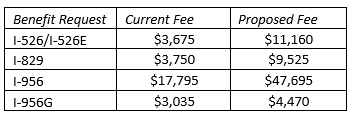
This is a member perspective and the views of the author are their own and do not necessarily reflect the views or position of IIUSA.
By Suzanne Lazicki, Lucid Professional Writing
READ IN PDF
The filing fees for EB-5 forms have remained unchanged since 2016, and overdue for adjustment. But how and when will EB-5 form fees will change? And will EB-5 fee increases result in better service or shorter processing times? The answers are critically important and complicated. This article provides analysis and resources to support informed stakeholder feedback for the fee-setting process.
When and how will EB-5 form filing fees change?
The DHS fee rule process provides one possible path to EB-5 fee changes. On January 4, 2023, the Federal Register published a Notice of Proposed Rulemaking (“22/23 NPRM”), which proposes to adjust filing fees based on changes to USCIS costs and the incoming benefit request workload. The 22/23 NPRM fee review covers all benefits handled by USCIS, including EB-5 forms I-526/I-526E, I-829, I-956, and I-956G.
The 22/23 NPRM fee review is currently in the public comment stage. USCIS held a listening session on January 11 to record live comments, and USCIS invites submission of written comments on the NPRM page until March 6, 2023. (The listening session offered no significant input from USCIS, but featured USCIS leadership expressing their personal commitment and attention to the public comment process.)
The new filing fees in the 22/23 NPRM are only proposals at this stage: not finalized yet, and still subject to change based on public input. The period from NPRM to filing fee change has historically been 6-12 months. The last successful USCIS fee change was proposed in an NPRM in May 2016 and published as a final rule in October 2016, and the new fees took effect in December 2016. In the following fee review, USCIS published a proposed rule in November 2019 that become a final rule in August 2020, but that rule was blocked by litigation before the fee changes had a chance to take effect.
In addition the agency-wide NPRM fee rule, EB-5 fees are also subject to revision in connection with a special EB-5 fee study mandated the EB-5 Reform and Integrity Act of 2022 (Integrity Act). As the NPRM Proposed Rule FAQ says “Notwithstanding the EB-5 program fees that DHS has proposed, DHS is also gathering the information necessary to evaluate the EB-5 fees to meet the additional fee guidelines and processing time requirements provided in the EB-5 Reform and Integrity Act of 2022. The law requires DHS to conduct a fee study no later than one year after the date of its enactment (i.e. March 15, 2023), and then, no later than 60 days after completing the study, to set fees for EB-5 program-related immigration benefit requests at a level sufficient to recover the costs of providing such services and completing the adjudications within certain time frames.”
The 22/23 NPRM fee study and the forthcoming Integrity Act-mandated fee study are different processes with different objectives. NPRM does not consider adjudication time frames. NPRM follows a cost recovery model that only accounts for USCIS costs and incoming workload; the Integrity Act study will have to use a different method to address the timely processing objective. The 22/23 NPRM fee study notes that the Integrity Act does not preclude DHS from adjusting fees in the interim via its traditional cost recovery model. USCIS will continue to collect fees for the EB-5 program “including as may be effected by a final rule for this proposed rule, until the fees established under section 106(a) of the EB-5 Reform and Integrity Act of 2022 take effect.” (NPRM pg. 9) Although yet to commence, the Integrity Act fee process could finish earlier than the NPRM process if USCIS meets the ambitious deadlines in the Integrity Act. But this remains to be seen.
How does USCIS propose to change EB-5 fees in the 22/23 Proposed Rule, and what is the thinking behind the proposed changes?
The 22/23 NPRM proposes new form filing fees and offers exhaustive detail regarding the objectives, methodology, assumptions, inputs, and formulas used to arrive at the fee proposals. Discussion of methods and inputs can be found in the 201-page Proposed Rule, in the USCIS Proposed Rule FAQ, and among the Supporting and Related Materials, particularly in the 66-page Fee Review Supporting Documentation, the 50-page Fee Review Model Documentation, and the 28-page Fee Schedule Documentation. Of the complaints justified by the fee process, “the fees weren’t explained” is not one. The challenge is patience to read the explanation. The following sections highlight and analyze content relevant for EB-5 stakeholders extracted from the voluminous USCIS material.
In short, the 22/23 NPRM proposes to increase EB-5 form filing fees by 150% to 300%, but it does not anticipate significant additional resources or staff for EB-5. The proposed EB-5 fee increase is driven by the assumption that EB-5 costs will remain fairly constant while volume of fee-paying receipts will drop going forward. The following tables show the NPRM calculation for proposed fees, followed by a discussion of each variable. (See this Excel file for the tables and additional detail extracted from the NPRM and supporting documents.)
Summary of Proposed EB-5 filing fee changes in the FY 2022/2023 fee review









